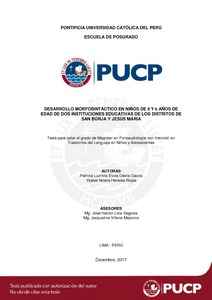| dc.contributor.advisor | Livia Segovia, José Héctor | |
| dc.contributor.advisor | Villena Mayorca, Jacqueline | |
| dc.contributor.author | Dávila Dávila, Patricia Luzmila Elvira | es_ES |
| dc.contributor.author | Heredia Rojas, Ysabel Noelia | es_ES |
| dc.date.accessioned | 2018-01-31T21:53:53Z | es_ES |
| dc.date.available | 2018-01-31T21:53:53Z | es_ES |
| dc.date.created | 2017 | es_ES |
| dc.date.issued | 2018-01-31 | es_ES |
| dc.identifier.uri | http://hdl.handle.net/20.500.12404/9975 | |
| dc.description.abstract | El objetivo de la investigación fue comparar el desarrollo morfosintáctico de niños
y niñas de 5 y 6 años del nivel inicial de dos centros educativos de gestión
paraestatal y privada de Lima metropolitana. El método que se utilizó fue
descriptivo comparativo que da a conocer las cualidades y características del
desarrollo morfosintáctico en estas edades, a través de la aplicación de dos
instrumentos, el Test de Comprensión de estructuras gramaticales (CEG) para el
proceso de comprensión y el Sub test de Formulación de Oraciones de la prueba
Evaluación Clínica de Fundamentos del Lenguaje (CELF-4) para el proceso
expresivo, y realizar la comparación de estos resultados según criterios escogidos.
Los resultados señalaron que de la totalidad de la población, un 29,1 % corresponde
al nivel bajo en el desarrollo morfosintáctico; un 43,7% al nivel promedio y el
27,2% alcanza un nivel alto en el desarrollo morfosintáctico en general. Además,
el estudio muestra que no existen diferencias significativas en el desarrollo
morfosintáctico en función al sexo, en cambio, en función al tipo de gestión
educativa sí se hallaron diferencias, lo mismo se evidenció en relación a la edad. A
través de la presente investigación, se concluye que es importante la estimulación
y exposición a modelos lingüísticos adecuados ya que posibilitan emisiones más
sofisticadas y bien organizadas en edades tempranas, siendo la familia y la escuela
los referentes de imitación. De otro lado, se debe considerar posteriores estudios
que aborden este componente a fin de tener más aportes para incluirlos en cualquier
labor de intervención. | es_ES |
| dc.description.abstract | The objective of this research was to compare morphosyntactic development of
children from 5 to 6 years old of initial level from two educational centers, one
private and the other parastatal management of metropolitan Lima. The method
used was descriptive comparative that shows the qualities and characteristics of
morphosyntactic development in children from this ages, through the application of
two instruments, the Test of understanding grammatical structures (CEG) to the
process of understanding, and the subtest Formulation of sentences from Clinical
Evaluation Language Fundamentals (CELF -4) for expressive to make a
comparison between both results according to chosen criteria.
The results showed that from the total population 29.1 % correspond to low level,
43.7% average, and 27.2 % reaches a high level in the morphosyntactic
development in general. In addition, the study shows that there are no significant
differences in morphosyntactic development in terms of sex, however according to
the type of educational management was found differences, as was evidenced in
function of age.
Through this investigation, it is concluded on the importance of stimulation and
exposure to appropriate language models enable to get more sophisticated and wellorganized
emissions at an early age, being the family and the school referents of
imitation. On the other hand, further studies should be considered to address this
component in order to have more input to include in any work of intervention. | es_ES |
| dc.language.iso | spa | es_ES |
| dc.publisher | Pontificia Universidad Católica del Perú | es_ES |
| dc.rights | info:eu-repo/semantics/openAccess | es_ES |
| dc.rights.uri | http://creativecommons.org/licenses/by-nc-nd/2.5/pe/ | * |
| dc.subject | Niños-- Lenguaje--Investigaciones | es_ES |
| dc.subject | Español--Morfosintaxis | es_ES |
| dc.subject | Niños--Educación preescolar--Perú--Lima | es_ES |
| dc.title | Desarrollo morfosintáctico en niños de 5 y 6 años de edad de dos instituciones educativas de los distritos de San Borja y Jesús María | es_ES |
| dc.type | info:eu-repo/semantics/masterThesis | es_ES |
| thesis.degree.name | Maestro en Fonoaudiología con mención en Trastornos del Lenguaje en Niños y Adolescentes | es_ES |
| thesis.degree.level | Maestría | es_ES |
| thesis.degree.grantor | Pontificia Universidad Católica del Perú. Escuela de Posgrado | es_ES |
| thesis.degree.discipline | Fonoaudiología con mención en Trastornos del Lenguaje en Niños y Adolescentes | es_ES |
| renati.discipline | 916137 | es_ES |
| renati.level | https://purl.org/pe-repo/renati/level#maestro | es_ES |
| renati.type | http://purl.org/pe-repo/renati/type#tesis | es_ES |
| dc.publisher.country | PE | es_ES |
| dc.subject.ocde | https://purl.org/pe-repo/ocde/ford#3.05.03 | es_ES |






